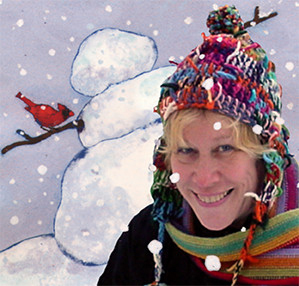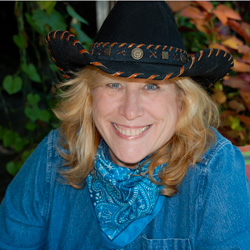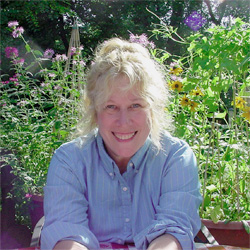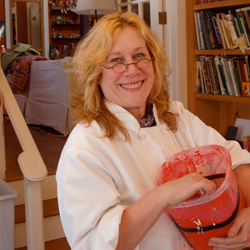Denise Fleming
I grew up in a comfortable, middle-class family in Toledo, Ohio. My father spent a great deal of his free time building furniture; my mother was very active in local theater. My sister and I divided our time between making things in the workshop and putting on neighborhood productions. We produced plays complete with commercials, circus entertainments, and fantastic spook houses in converted refrigerator boxes. One thing my mother was very firm about, regarding any of these productions, was that we were to charge either buttons or straight pins as admission.
In third grade, I was chosen to participate in classes at the Toledo Museum of Art. Several of my paintings were included in art exchange programs with other countries. One of my paintings was chosen to be the cover of a teachers' magazine. I was published!
Over the years, my work changed, then changed again. I now work primarily in paper—creating images by pouring colored paper pulp through hand-cut stencils. I feel that my art has come full circle from the bold, colorful paintings of childhood, through a period of tight, detailed images, and back again to bold, colorful, more childlike images.
Papermaking for me is cathartic. Part of its appeal is that it's very physical—toting buckets of water, beating large quantities of pulp, hand-mixing huge vats of color. It's different from the Bob Cratchit-like existence that my former finely detailed style required—hunched over my drawing board with electric pencil sharpener close at hand. What other medium requires that you be up to your elbows in brilliant color?
Cotton rag is the basic material in pulp painting. The rag is beaten to a fine pulp and suspended in water. Chemicals and pigments are then added. This pulp is my paint; cups and squeeze bottles serve as brushes; hand-cut stencils are my underdrawings.
To begin, I dip a large screen into a vat of pulp suspended in water. The water drains off through an underlying screen and damp pulp is left on the surface of the screen–this serves as a base sheet to which I add shape and color by using the stencils I've made, cups, and squeeze bottles. I layer and slowly build up the pulp. Some of the sheets are three quarters of an inch thick before I press and dry them.
There is always an element of surprise in pulp painting, as I cannot completely control the blending of color and fiber. Each fiber retains its individual color–this and the layering of fiber create a feeling of depth in the finished painting.
In the Tall, Tall Grass was my first book in which I used pulp painting as a medium. The story is a distillation of summer afternoons spent with my daughter in the woods and field near our home: the hot sun, the drone of bees in the grasses, birds in berry bushes, grasshoppers and crickets bouncing at our feet. In the book you will see these blue-sky, hot summer days depicted in yellow, because they feel very yellow and hot. I use strong color, not always the colors that nature chooses, but color that conveys the mood and movement of a particular creature or moment.
My books do not have many words, but I start with hundreds of words—writing and rewriting until I have just the right words to tell the story. (I love strong words, action words, words that convey movement and sound. And I love rhyme.)
I don't work alone. My books are a family effort. My husband, David, who is also an artist, not only makes my screens and totes my pulp, but together with our daughter Indigo serves as a wonderful sounding board. Together we review words, pictures, and ideas for new books!







